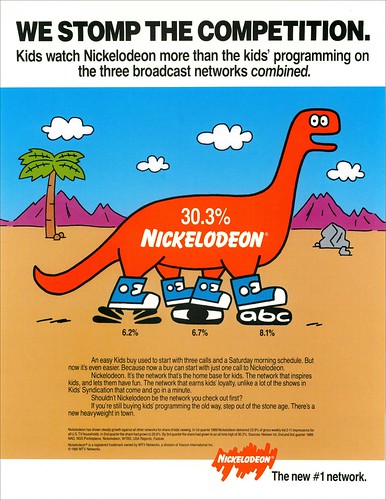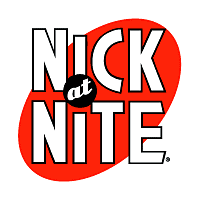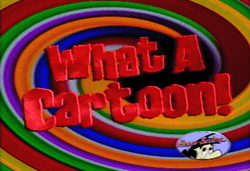Kevin- What is your favorite cartoon character?
Fred- Of the Frederator characters? You don't think I like any one kid more than another, do you?
Kevin- What were your favorite cartoons growing up?
Fred- Huckleberry Hound, Bugs Bunny, and The Flintstones.


Patricia- Who were your influences?
Fred- My Mom and Dad, first and foremost. Next biggest were The Beatles, who came to America when I was 12 and led my way from being a chemistry major into music and the media. They're the ones who showed me you could be artistic and commercially successful without any compromise whatsoever.
Patricia- Did your parents support your decisions of what you wanted to do with your career?
Fred- My parents were scientists who really thought I would follow in their footsteps; I was a real science and math geek. But, at the same time, they always encouraged me to find what I loved and chase it. When I wanted music lessons at six they were all for it, and when I formed rock bands in the wake of the British Invasion of the mid 60s, they were at everyone one of our gigs. They were pretty confused when I dropped out of a science major and announced I was going to be a record producer (they had no idea what that was; truth be told I don't think I did either), but once they saw I'd made my mind up, they went along. When I started my first company (Oblivion Records: http://frdr.us/GELe9q) they at least realized that I wanted to make a living at my passions.
Patricia- Can you tell us the story of the how the iconic Nickelodeon splat logo came about?
Fred- Well, it's a long story, and you might want to read more of it here: http://frdr.us/vLTQmg (or you can pull any quotes for the interview, if you'd like). And, the Nick logo wasn't a "splat" at all, at least not only a splat.
In the early 1980s, I was the original creative director at MTV and had developed their iconic logo with Manhattan Design, the company of my oldest childhood friend, Frank Olinsky. One it's most distinctive innovations was the fact that it wasn't a completely fixed entity, with "official" colors and uses. It seemed to me that if we were designing for television, a moving picture medium, it was foolish to design logos for print usage, only to hand them over to "motion graphic" specialists who would try to figure out how to make the darned thing move. Frank and his partners solved that problem up front.
By the time the Nickelodeon assignment came up, I'd left MTV Networks (Nick's parent company) to form Fred/Alan, Inc. with Alan Goodman; we were the first "branding" company in television. Tom Corey and Scott Nash of Corey, McPherson, Nash in Boston, were among the only other designers we worked with that understood that notion of designing for movement so we asked them to develop the Nick logo with us. They were a bit skeptical, especially because the name was ridiculously long, couldn't be spelled by any kid anywhere, and didn't really mean anything to anyone in the late 20th century. Eventually, we convinced them to help.
Then Tom and Scott showed us that, in fact, there wasn't one logo at all, but 100, 1000, 1 million if we wanted. Any shape we wanted could be a Nick logo, as long as it was Pantone #021, and had a certain Nickelodeon logotype inside. (Here's 168 variations: http://frdr.us/GEGyCu). They showed us how we should just slap it on top of whatever was happening on the screen, and that the orange ("a color rarely found in nature") thing would stand out really clearly.

After a bit of pushback from the company's management, we prevailed, and for 25 years our logo ruled the airwaves.
Patricia- How did the process of creating Frederator Studios come about?
Fred- I'd been the last president of the famous Hanna-Barbera cartoon studio and had a hand in reviving its creative fortunes with the What A Cartoon! shorts incubator (The Powerpuff Girls, Dexter's Laboratory, Courage the Cowardly Dog, and others) when Ted Turner (owner of HB's parent) sold the company to Time Warner. I loved working for Ted and Scott Sassa (my immediate boss) and didn't really want to be a cog in the wheel at a huge conglomerate.
Patricia- What was your favorite era of Hanna Barbera cartoons?
Fred- Well, of course, I'm partial to the cartoons we made when I was there in the 1990s.
But, we never would have made any of them without the groundbreaking work done by Joe Barbera and Bill Hanna in the first decade of the studio. The shorts shows of Huckleberry Hound, Quick Draw McGraw, Yogi Bear were the first ones that turned me on as a kid, and when The Flintstones debuted as the first primetime cartoon ever (I was nine years old) I was a fan for life.
Kevin- What is it like working with Butch Hartman?
Fred- Butch Hartman is completely unique in the modern cartoon business. He's talented, wants people to love his stuff, and he's one of the hardest working men in show business.
One of his great qualities is his certainty that he can take anything and make it funny. One of the truths of the commercial media business is that there's a lot of money at stake, and so there are a lot of nervous executives who are always giving you their ideas as to how to make an episode better, funnier, whatever. Butch is one of the few creative people I know who isn't at all phased. Bring it on; he knows that anything you can throw out at him and his team, they can figure out a way to make it work so the audience is happy.

Kevin- If you can choose one classic cartoon show and modernize it, what would it be and why?
Fred- You know, my answer would be "none." To my eyes and ears, why update something that's already great?
(This opinion comes from hard won experience).
I had a good run when I asked producers Donovan Cook and Larry Huber to update Secret Squirrel. They did a a fantastic job taking a great character who had a boring show, and made Super Secret Secret Squirrel, a funny show that never got it's due.
On the other hand, I had the bright idea of updating the classic Jonny Quest and had the studio do a remake called The Real Adventures of Jonny Quest. The less said about it the better, other than it almost ruined the studio and my career in cartoons.)
Kevin- What attracted you into animation?
Fred- I like the art, but mainly I love the laughter.
Kevin- What is your favorite Cartoon Network show?
Fred- Duh. Adventure Time.
Fred- Triple duh. The Fairly OddParents, Fanboy & Chum Chum, and Wow! Wow! Wubbzy!
Kevin- Do you have any merchandise on any of the shows that you produced?
Fred- I'm not sure what you mean by this question. I have it all!
Kevin- What do you think of CGI now becoming the dominant animation of most cartoons nowadays?
Fred- I have a fondness for for traditional 2D animation, since it's what I grew up with. But honestly, I could care less about production techniques. If I'm in love with a character and a story, I'm happy. Even if it's made with paper cut outs.
Kevin- Why do you think that they're not as much animated shows based on movies anymore?
Fred- Well, there are lot coming out now, especially at Nickelodeon. I'm probably the wrong person to ask about this because I don't really enjoy those shows too much. Movie stories and TV stories are really different, and I'm not so sure that they crossover all that well.
Kevin- What is your favorite animated film?
Fred- A few years ago I probably would have said Disney's Pinocchio. But right now I'm definitely in love with the Toy Story trilogy.
Patricia- What was your vision and creative ideas when you became the first creative director for MTV?
Fred- You might find this hard to believe, but I wanted to take the energy of Looney Tunesand translate it into rock'n'roll. It might have been more complicated than that when it came to the execution, but that's literally where it started for me and my original creative partner, Alan Goodman.

Patricia- How did you come up with idea of Nick-at-Nite? What shows did you know that you wanted to put in it?

Fred- I worked in college radio at Columbia University's WKCR-FM where there was a decades long tradition of preempting all programming for a 24 hour Beethoven's Birthday Festival. Some of my friends and I adapted it for famous. jazz artists and we found that consistently during our fundraisers the marathons always garnered the highest contributions. Clearly, people really enjoyed them.

My favorite over-the-top marathon was one that we all thought would fail. I suggested we do The Mary Tyler Moore show back-to-back for one solid week. When the ratings at 4am turned out to be higher than most other cable networks' primetime numbers, we knew we had a big score.
Kevin- What was it like being one of the last presidents of Hanna Barbera Cartoons, Inc.?
Fred- I was Boo Boo Bear's boss! How could it get any better than that?
Kevin- What did you think of Hanna-Barbera when Ted Turner and his company bought the studio?
Fred- I had always loved Hanna-Barbera, back to my excitement about Huckleberry Hound and The Flintstones. The more people tried to make fun of their limited animation, the more adamant I was that they were my favorite cartoon studio. It was only heightened when I started traveling to Los Angeles for work and would pass the monumental building with the simple HANNA-BARBERA sign in Helvetica at the top in black and white. As I got older, realized their "limited animation" technique was paralleling a lot of simplifying that was going on in all the popular arts in the 50s and 60s, especially rock'n'roll, and it just made me a bigger fan.
In fact, I originally developed the concept as a consultant at Nickelodeon, before they were doing original animation. They thanked me while they were rejected it, only adapting the shorts concept as doing "pilots" which, believe it or not, was not done in TV cartoons at the time.
The basic notion was that I kind of hated all the cartoons I'd been seeing on TV for years. They seemed dull and uninspired, nothing more than low quality sitcoms, but animated. Nothing like the great cartoons that were done in the 1940s and were constantly running on TV when I was growing up. It seemed ridiculous to me that they'd made great cartoons before I was born, but couldn't do it now. Surely, there must still be great, talented cartoonists out there.

Patricia- Out of the 48 cartoon shorts that were shown in What a Cartoon, only five were chosen to be full on cartoons; Dexter's Laboratory, Powerpuff Girls, Johnny Bravo, Courage the Cowardly Dog, and Cow and Chicken. What made them so special or unique compared to the others that you knew that they had what it took to become successful cartoons?
Patricia- In one of the shorts was Larry and Steve by Seth MacFarland, which became a precursor to the popular cartoon Family Guy, but it was never produced on Cartoon Network. Do you regret not producing the cartoon first?
Fred- Yes.
Fred- Too many to mention.
Kevin- What advice would you give to someone who wants to go into the animation business?
Fred- If someone wants to be on the creative side of the business, learn to draw and learn to write. There are a lot more complicated answers, but they all boil down to the same thing.
Patricia- What do you think is the secret to your amazing success?
Fred- This answer will seem unbelievable, but the truth is that I was too stupid to know how difficult it is to succeed. Every time I got knocked down, I dusted myself off and started over. It's probably more important than anything else I could tell anyone.
Patricia- What made you come up with the idea of doing the first cartoon podcast?
Fred- Channel Frederator as a video podcast was actually conceived by a young engineer who'd been our intern, David Karp. And, oh yes, David went on to become the founder of tumblr.
.jpg/220px-David_Karp_EBE09_(cropped).jpg)
Patricia- Can you tell us anything about the upcoming Samurai Jack movie? How's that coming along?
Fred- Genndy Tartakovsky and Frederator are still hard at work on Jack. The movie is still "in development," as they say in the biz. That is to say, we still haven't figured out a way to pay for it. Getting the many millions of dollars needed to produce a project that's considered risky --remember, there really isn't an example of a low budget, 2D animated feature film that has been a success at the box office-- is often a process that takes many years.

Kevin- Did you ever think about voicing a cartoon character yourself?
Fred- Hah! That would be a very bad idea.
Patricia- What are your upcoming projects?
Fred- We just announced our latest animation projects earlier in March (bit.ly/zGAD2n).
Our Cartoon Hangover channel for adults will launch on YouTube in early summer with three series.
• Bravest Warriors was created by Pendleton Ward for Random! Cartoons right after he finished Adventure Time. The show will be produced by Breehn Burns, the creator of Dr. Trans.
All in all, we're thrilled to be back on the front lines of identifying the newest generation of great cartoon talents.
Patricia- Alright, that should be it. Fred, thank you so much for this wonderful interview. We are so thankful for you taking the opportunity from your busy schedule to do this.
Fred- Thanks Patricia and Kevin.
To find out more about Fred Seibert's work, you can check out his website fredseibert.com For other websites, check out Frederator Studios' official website frederator.com as well as channelfrederator.com and nextnewnetworks.com. Also follow him on Twitter at @fredseibert.
That's all for now. Hope to see you at Old School Lane soon. Thanks for reading.
-Kevin and Patricia

No comments:
Post a Comment